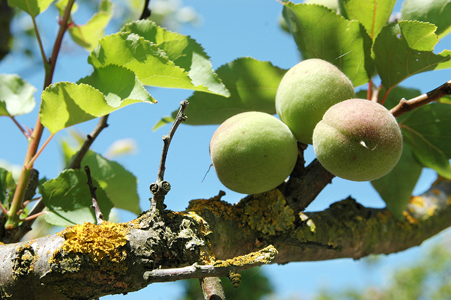
Foreign competition, labor shortages pressure a once-dominant
fruit in area orchards
At one time, apricots defined Hollister. Now, unless current
trends reverse, they are destined to become a footnote in San
Benito County history.
The Blenheim (pronounced blen-hem by growers) is a drying
apricot that is favored by culinary aficionados for a superior
flavor, and is the chief ‘cot grown in the county. But factors
including plowing under orchards for housing developments and cheap
foreign competition has dramatically reduced the local acreage, and
some say romance, of the Hollister apricot.
Foreign competition, labor shortages pressure a once-dominant fruit in area orchards
At one time, apricots defined Hollister. Now, unless current trends reverse, they are destined to become a footnote in San Benito County history.
The Blenheim (pronounced blen-hem by growers) is a drying apricot that is favored by culinary aficionados for a superior flavor, and is the chief ‘cot grown in the county. But factors including plowing under orchards for housing developments and cheap foreign competition has dramatically reduced the local acreage, and some say romance, of the Hollister apricot.
“The apricot industry is definitely in a declining mode,” said Bill Ferreira, president of the Apricot Producers of California in an interview with Ag Alert, a publication of the California Farm Bureau. He added that in the past five years, roughly 4,000 acres of apricot trees have been plowed under, while only 200 acres have been replaced.
At the beginning of World War II, more than 22,000 tons of apricots were grown on nearly 5,000 acres in San Benito County, according to the 1941 county crop report. By the time of the Iranian hostage crisis that number had fallen to 17,000 tons grown on 2,700 acres. And by the time President Bush was being sworn in for his second term, only 1,222 acres remained in production and fewer than 4,100 tons were produced.
One hundred of those acres still in production belong to B&R farms off Fairview Road in Hollister. The Rossi family harvested its first crop of Blenheims in 1929, and three successive generations have tended the orchard since then. But they are under siege.
Foreign competition, dwindling labor supplies and land-use policies that favor growing houses over the golden-yellow fruit has Mari Rossi worried.
“Turkey can pick, produce and get it here cheaper than we can get the fruit off the tree,” she said.
Imports of dried apricots from Turkey “virtually own the U.S. market now,” said Dave Kranz, a spokesman for the California Farm Bureau. While cheap offshore labor is one culprit, government subsidies in those countries play a key role, Kranz said.
“Imports began to hit California farmers in last decade or two,” he said. “California growers are competing on world market, and if you are an apricot grower you are not only competing with other fruits, but even more so you are competing with your counterparts in Turkey or China. In some cases there are nations that provide crop subsidies or export subsidies,” dramatically lowering the costs for foreign farmers to compete in the U.S. market.
While labor cost wildly differ between Asian and the U.S., growers here are faced with an increasingly hard time finding enough pickers to harvest the crops. B&R farms had a difficult time contracting enough labor last year to harvest its crop of apricots, and this year remains uncertain, Rossi said.
Stricter border control along the U.S. Mexican border is contributing to the labor shortage, Kranz said, but not in the way you may think. Immigrants, while finding it more difficult to enter the country, are finding it even harder leave the country.
“The pattern historically has been migrant workers come in spring and summer, follow the crop and then return to their home countries after harvest is over,” he said. “Now, with the difficulty getting in or out, the may try to stay in the U.S. Those who stay look for year-round work, which farms can’t provide.”
So immigrants turn to hotels, restaurants, manufacturing and the construction trades for year-round income. While the Farm Bureau supports the need for secure borders, throwing a fence up on the border without providing for an effective guest-worker program will only hurt U.S. farmers and consumers, Kranz said.
“We have a couple of dozen farmers going back to Washington [this] week to talk about immigration,” Kranz said. “We need a program to allow workers to enter the country legally.”
While the Rossi family and other local growers try to combat these man-made threats, Mother Nature threw them a curve this year with the heavy, sustained rains late into April. Heavy rains can pound away at the fragile apricot blossoms and thin the crop.
Saturated soils are just now allowing B&R farms to get out into the orchards to inspect the damage, and while it’s still too early to make an accurate estimate, Rossi said preliminary reports suggest this year’s harvest could be on the lighter side.
Of course, getting equipment into orchards requires fuel for the tractors – yet another escalating cost to growers already struggling with a seemingly endless parade of assaults that is quickly sending the local apricot industry toward a time when old-time Blenheim growers begin their sentences with “remember when …”









